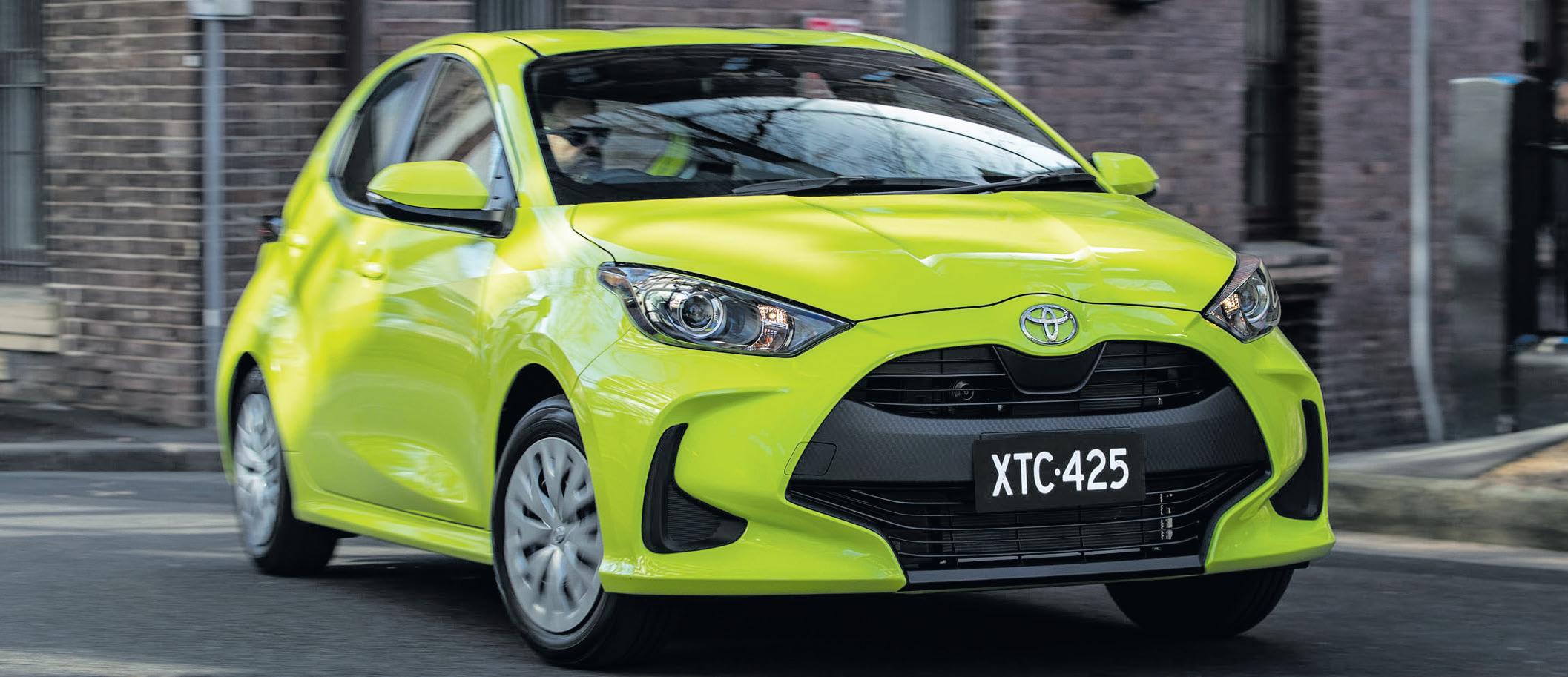
14 minute read
Motoring
A long road . . . the Yaris Ascent Sport hatchback passes the family test SMALL MOVES TOWARDS HAPPY FAMILIES
By DEREK OGDEN
It may be short on words but ‘family car’ is long on the desirable characteristics of a passenger vehicle: affordability, space, versatility, comfort and convenience, power reliability, fuel economy, safety and last, but not least, looks, all jostle to be taken into consideration.
This goes a long way to explaining the success of the fve and seven-seat sports utility vehicle, or Mum’s minibus, the eight-seater people mover, which can take the kids and all their kit.
However, there is another side to family life. Sons and daughters leave home and start families of their own. It is often left to Mum and Dad to bring the family together with visits to their offspring.
A gas guzzling minibus is the last thing the downsized duo needs. This is where a small economical runabout comes to the fore. – something like the Toyota Yaris Ascent Sport hatchback, a versatile compact capable of carrying four adults, or a couple and all their luggage, the latter on a considerable road test distance.
At an affordable $22,130, plus onroad costs, the car is the entry level to the Yaris line and the only variant with a six-speed manual transmission. The others, including petrol/electric hybrids, have a direct shift CVT, which adds just $1500. A CVT-equipped hybrid on SX and ZR attracts a further $2000 over their equivalent petrol variants.
Ownership costs include a fve-year warranty, extendable to seven years, up to 10 years on the hybrid battery and fve annual services capped at $195 each.
Conveniently to hand on Ascent Sport is standard equipment which includes Apple CarPlay and Android Auto, LED daytime running lamps, tail and stop lights; auto retractable door mirrors with LED turn signals; and power windows.
For the frst time on a Toyota vehicle in Australia there are safety features designed to make Yaris the world’s safest compact car. They include front-centre airbags, sensors that can detect vehicles or pedestrians at intersections when making turns and secondary collision braking.
STYLING
The all-new Yaris is shorter and lower than its predecessor, with a longer wheelbase (40 mm). Despite the lower roofine, interior headroom is not compromised, the driver and passengers sitting lower thanks to the new Toyota B-platform.
A sporty exterior boasts astand-out cascading grille, longer bonnet, sculpted door panels, character lines and a shorter rear overhang.
There are 12 exterior colours, including Cherry Blossom in the case of the test vehicle, which elicited compliments from onlookers who marveled at the subtle change of hue from off-white to lavender, depending on the light.

INTERIOR
Toyota Yaris Ascent Sport has an all-black interior, offering an open, spacious and comfortable cabin with ample headroom and an up-market ambience with high-quality seat fabrics. Despite a wider centre console, there is no room for an armrest, hence no leaning post for the driver. Gearshift and cup holders take up the space.
However, the new platform allows the driver’s seat to be set lower and further back towards the centre of the car, creating an appealing driving position and helping to lower the vehicle’s centre of gravity by around 15 mm.
The steering wheel is set closer to the driver, with wider tilt and telescopic adjustments. Electric steering is tuned for a light feel at low speed and responsive feeling at high speed.


INFOTAINMENT
Driver information is sourced through a 7-inch touchscreen and a 4.2inch multi-information display in the instrument cluster.
Bluetooth connectivity includes phone and music. With enhanced voice recognition, there’s access to Sir, Eyes Free, Google Now voice commands. AM / FM / DAB+ digital radio is in the hands of six speakers, while USB video playback is on offer when the vehicle is stationary.
ENGINES / TRANSMISSIONS
The new direct-injection three-cylinder 1.5-litre petrol engine’s 88 kW and 145 Nm forge gains of 10 per cent and 2.7 per cent over the previous 1.5-litre four-cylinder engine, the result of a lighter block and crankshaft, reduced frictional losses and high-speed combustion technology.
SAFETY
Advanced safety technologies include a pre-collision safety system with autonomous emergency braking, active cruise control, automatic high beam, and technologies to assist with cornering, staying in the intended lane and detecting speed signs.
A reversing camera and a full suite of brake assist and traction-control systems, including active cornering assist are also standard. Eight airbags include driver, front passenger, two front centre, two front side, two curtain shield.
The new front-row centre airbags – a frst in class – are designed to offer additional protection in a range of accidents. They can act as energy-absorbing cushions between the driver and front passenger in side crashes, or in passenger-side crashes when the driver is the only occupant. They can also provide safety benefts in rollover accidents.
DRIVING
The initial plan was for the Ogdens to visit their daughter in Sydney from south-east Queensland without getting caught in the domestic air travel chaos, or risking catching COVID-19. Fortunately, the kind folk at Toyota Australia found a spare Yaris lying around and offered it up for the drive.
As we, the intrepid pair, were about to set off, came the news that an old family friend had died in Melbourne and the funeral was to take place while we were in Sydney. What were the chances of driving on to Victoria and back in the Yaris? Following a phone call to Toyota, every chance.
The result was a 3700-kilometre round trip in a vehicle that would have been far from the top of the list in which to tackle such an exhaustive exercise. How wrong we would have been.
The entry-level Yaris Ascent Sport had the last laugh, lapping up the highway kilometres, or taking on heavy traffc in the country’s two largest (and congested) cities. Although the lack of factory-ftted sat-nav was a drag. Google is no competition here.
The new 1.5-litre petrol engine produces more power and torque, while using less fuel than the 1.3 and 1.5-litre four-cylinder engines it replaces. Tagged with the ‘Sport’, engine performance is not all that impressive. In slow city traffc high revs are the key otherwise stalling is the downfall.
Toyota claims the new Yaris manual uses just 5.4 litres of fuel per 100 kilometres on the combined cycle. The test car clocked 7.9 litres per 100 kilometres while fitting around towns on the route and 3.7 litres per 100 kilometres on the open road. Total fuel bill came to $286.47, thanks, Toyota.
The little motor was quiet enough at low revs but let out a raspy reply when urged to work higher up the scale.
The manual gear shift at times was not of Toyota’s usual high standards and needed frm handling to avoid connecting with the wrong gear.
On the upside, the new platform underpins a signifcant increase in body rigidity, which contributes to agility, stable handling, ride comfort and lower noise and vibration.
A 270-litre cargo area incorporates a two-level deck board. Big items – two large suitcases in the case of our excursion - can be accommodated with 60:40 split-fold rear seat backs folded fat. Front door pockets take up to a dehydrationbeating 1.5-litre bottle, rear door pockets up to a 600ml bottle.
SUMMARY
The test took place mostly under clear winter skies, all on sealed roads, the Yaris also coping with early morning frost in the Southern Highlands and being rain bombed on the Hume, all the way to drawing together relatives and friends – a genuine family car.
DISCOVER OUR RANGE, CARS FROM $11,990
GIBBO’S
AUTOPARTS

Mon - Fri 8am-5pm, Sat 8am-1pm , Sun 9am-12pm
Polestar 2 . . . taking the fght up to Tesla POLESTAR 2 LONG RANGE SINGLE MOTOR
BY CHRIS RILEY
The Polestar brand is an offshoot of Volvo and has been positioned as a standalone range of performance electric vehicles.
At launch the price started at $59,000 but as is often the case the price has gone up. The single motor, standard range, front-wheel drive model is now priced from $69,335 driveaway.
The long-range single motor version is $74,060 driveaway while the range-topping long range, dual motor model, with all-wheel drive is $79,310 driveaway.
Metallic paint is standard, and all models start with the same basic range of equipment. Standard kit includes embossed, textured leather upholstery and two-zone climate air conditioning.
STYLING
Polestar 2 has a sloping tailgate that rises to reveal a long but shallow luggage area, with a hidden storage underneath.
Polestar 2 was designed by Thomas Ingenlath alongside the Volvo Concept 40.1 which later became the basis of the XC40.
In hindsight the decision to incorporate a radiator grille was a good one, because it avoids the goofy look that some EVs project. It looks classic and classier. There are 19-inch alloys, LED headlights with active beam, adaptive rear LED lights, retractable frameless mirrors, auto lights and wipers, auto-dimming rear view mirror, front and rear park sensors, and a foot operated tailgate.
Additional features can be added to single motor models with the $3400 Pilot Lite pack or $6000 Plus pack.
Pilot Lite Pack adds Adaptive Cruise Control and Pilot Assist, auto dimming for side mirrors plus a further four parking sensors and 360-degree birds eye camera view.
Plus, it adds a heated steering wheel, full power seat adjustment, an energy-saving heat pump, air fltration system, wireless phone charger, 600 watt 13-speaker Harman/Kardon audio along with a full-length panoramic glass roof.
Our test vehicle was ftted with the Plus and Pilot Lite packs as well as ventilated Nappa leather, the latter an additional $6000.
Like many manufacturers Polestar has not escaped the global shortage of electrical semiconductors.
The car we drove was ftted with LED pixel headlights with adaptive high beam. It’s been forced to replace this with less sophisticated LEDs with active high beam (minus cornering functionality).
Welcome and farewell light sequences have been replaced with fade in/out animation.
All of this puts the car a fair way up the food chain and a long way from the entry level model we had anticipated, taking the price as tested to $83,800 plus on-roads.
Buying a Polestar is a bit different too. The whole process takes place online from order to payment.
What about a test drive, I hear you ask? You can book a test drive here, either at a designated ‘space’ in each capital city or at a location of your choice.
Polestar offers a fve warranty, along with fve years complimentary servicing and roadside assistance. The battery is covered by an 8-year/160,000km warranty.
INFOTAINMENT
Infotainment is dominated by a huge Tesla-like 11.2-inch portrait style touchscreen.
High Performance Audio delivers 250 Watts through eight speakers, including a bass-boosting air woofer mounted under the bonnet -- just below the windscreen.
Polestar 2 is the frst car to come with a built-in Google infotainment system. It includes Google Assistant, Google Maps, with charging options and Google Play Store, which offers optimised in-car apps for seamless integration.
iPhone users have not been forgotten, with Apple CarPlay/Siri now included. The system is connected to the net and receives over-the-air updates like a phone.
Polestar 2 makes automatic emergency calls in the event of a crash or if the car has been stolen.
There are two USB Type-C connections in the front and two more in the rear of the car.
You can use them to charge compatible devices, but they do not offer a data connection.
POWERTRAIN
With a 78 kWh Lithiumion battery, 75 kWh of which is useable, the electric powertrain in this particular model produces 170kW of power and 330Nm of torque, with drive to the front wheels through a single reduction gear transmission.
SAFETY
Safety is surprisingly something of a grey area.
Polestar 2 gets a full fve-star crash rating from ANCAP, with a rear-view camera and seven airbags including a centre airbag.
There’s also autonomous emergency braking (Car-to-Car, Vulnerable Road User and Junction Assist) as well as a lane support system with lane keep assist, lane departure warning and emergency lane keeping and an advanced speed assistance system.
What you don’t get as standard are blind spot warnings, cross traffc alert with brake support, rear collision warning and mitigation, nor adaptive cruise control – which are all part of the $3400 Pilot Lite pack.
Just as surprisingly, there’s no head-up display for the windscreen either.
I guess the Polestar brand doesn’t share Volvo’s emphasis with safety.
DRIVING
Driver and front passenger seats are heated and partly power adjustable, with four-way power lumbar adjustment for the driver. The angle of seatbacks must be adjusted manually, however.
Inside, it’s very Swedish. Very minimalist, with wood veneer trim and a cabin that has a light, bright airy ambience.
But it’s not all peaches and cream. My feet kept getting tangled under the pedals as I got in and out of the car and my wife who spent a bit of time in the back tells me there’s not much room back there.
The dash from 0-100km/ h takes 7.4 seconds. Power consumption is listed at 17.1 to 18.6 kWh per 100km.
The standard range, single motor model has a range of 478km (WLTP), the long-range model we’re driving gets 551km and the long-range dual motor is good for 487km.
Charging takes as little as 35 minutes using a public, high-powered DC fast charger or eight hours with a home wall box -- that is if you have threephase power.
No word on an ordinary 10A power point.
A seven-metre charging cable helps make charging more convenient along with the option of Mode 2 and Type 1 connectors.
Although the range is listed as 551km, in reality the most we saw was 440km even when the car was fully charged, considerably less than promised.
A trip into Sydney, a distance of about 160 km return, used about 30 per cent of the charge – which in theory means you could do it three times before needing to recharge.
Like the XC40 Recharge we drove recently, there’s no key or start button. You just hop in, put your foot on the brake, put it into drive or reverse and off you go.
Acceleration is quick, but not lightning quick. It’s fast enough however to make you think you’re behind the wheel of something a bit special.
Helping keep the battery topped up is regenerative braking, which reclaims power when the car travels downhill.
You can choose between two levels of regenerative braking and adopt a onepedal form of driving where there’s no need to apply the brakes. Lifting off the accelerator brings the car to a stop. It takes some practice but may not be to everyone’s liking.
Because of the batteries, the car weighs over two tonnes, but has a low centre of gravity which helps it to sit fat in corners. Pushed too hard however and it has a tendency to run wide. The ride is sporty or in other words a little on the frm side but can be jarring on poor roads.
The weight gives it a big car feel in the way the suspension responds, taking a little longer to respond to bumps.
At this point I should mention a major hiccup we experienced while driving the car. Waiting for the lights to change at a major intersection, it took two rotations of the traffc lights before we could get through.
When the lights fnally turned green and we hit the accelerator, nothing
happened. The car had turned itself off, or at least had gone into park mode while waiting. The guy behind wasn’t too impressed, let me tell you.
I’m not big fans of Google Maps, I prefer the more user-friendly Waze, which is basically Maps with a different interface. Waze also supports speed camera warnings.
SUMMING UP
In the electric car world, it’s all about price and range.
The Polestar 2 looks the goods and ticks both of these boxes, but you might want to consider this.
Until electric vehicle infrastructure catches up with petrol, you’ll always be planning your life around the car. When and where it can next be charged and how long it will take to accomplish this task.
Even if you shell out for a wall box at home, it is still going to take several hours and to keep ahead of the curve, you need to top it up as frequently as possible.
In real terms, however, Polestar 2 could easily replace that petrolpowered car in your driveway.
Polestar estimates a sixmonth wait for delivery (more if you option the 19-inch 5-Double Spoke Black Diamond Cut Alloy Wheel).












